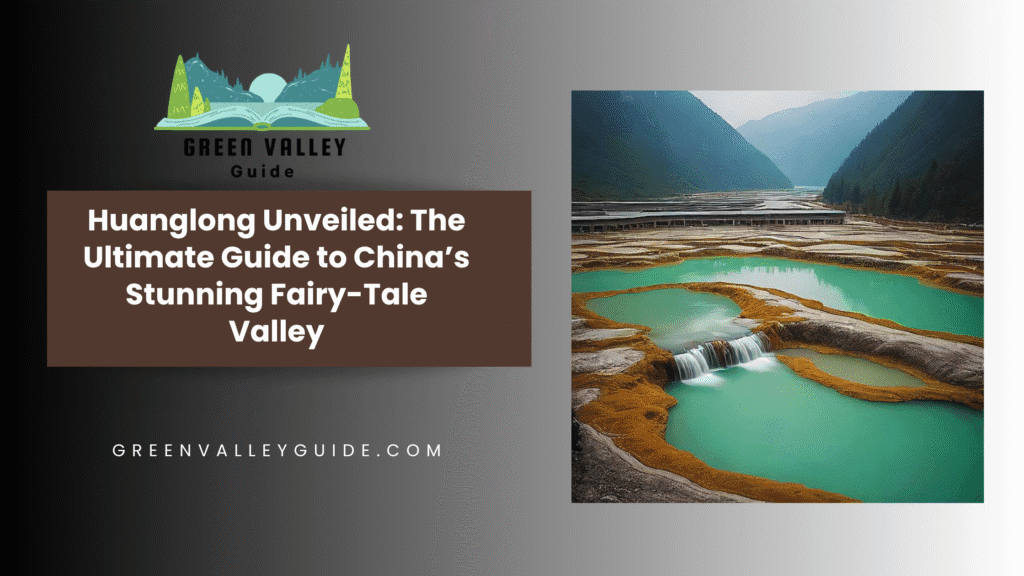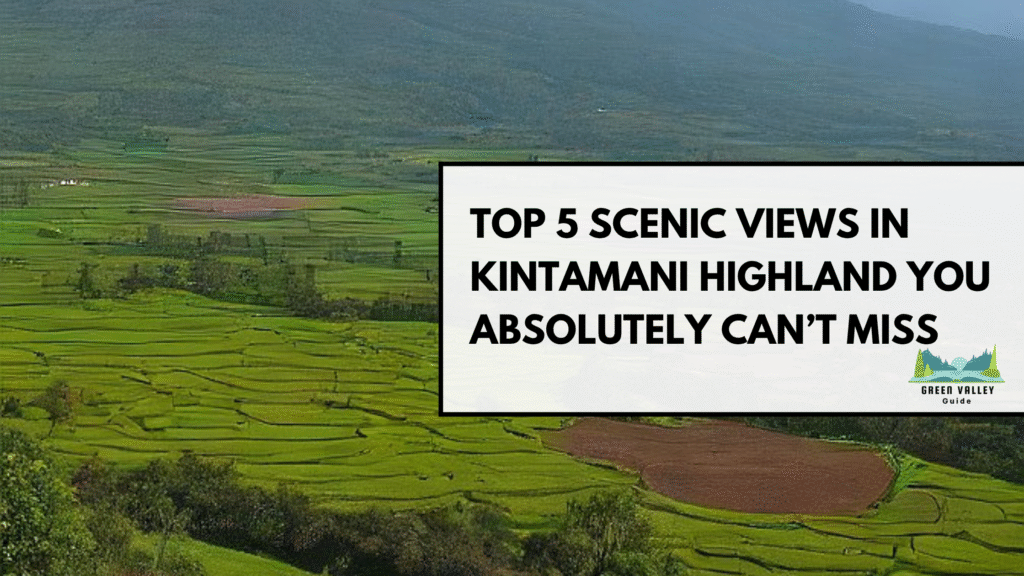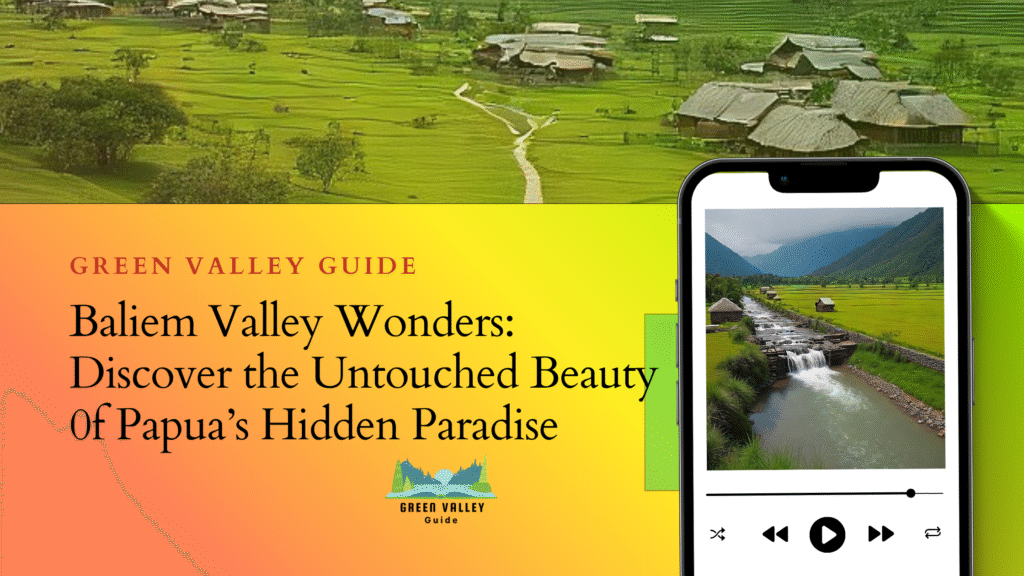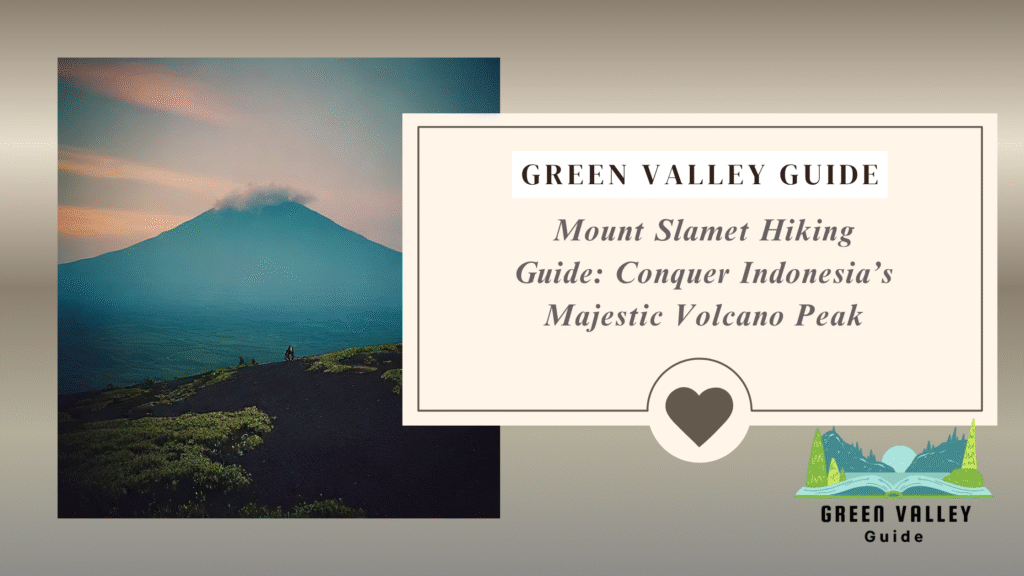Table of Contents
Introduction: Discover the Magic of Huanglong Valley
Deep into the wild, at subsequent end of Sichuan Province, at the end of the Minshan Mountains, is a place so unreal that you have entered into another reality. The Huanglong or Yellow Dragon is a shimmering colored region, a holy mythology, and a superb natural site.

Representing the UNESCO World Heritage, Huanglong is A UNESCO World Heritage site that resembles a fairy tale location–and it has every reason to be. Here, the tourists welcome a flowing ribbon of travertine terraces whose mineral-laden pools shine in turquoise blue, emerald, and gold shades. Around this Technicolor cornucopia sit snow-capped mountains, thick alpine forestation, and clean-running waterfalls dropping down clean-cut valleys.
Huanglong is not only an optical phenomenon. Its centerpiece is an ancient Taoist temple, a reverberation of the spiritual heritage of the mountain. Exotic wildlife such as golden snub-nosed monkeys, birds, and other animals roam the region, and hence it is a destination not only for nature lovers but anyone in need of peace, spirituality, and attachment.
Huanglong is a dream that offers the visitor who has ever wished for a lifetime fantasy walk, an opportunity to come and experience the beauty.
Where is Huanglong, and Why Is It So Famous?
Huanglong is situated in yet another province known as northern Sichuan, bordering one of the more renowned attraction sites, i.e., Jiuzhaigou Valley. Being in the mountaintops of the Minshan mountains, and rising above more than 3000 meters of sea level therefore Huanglong is a destination that is up in the air that treats nature lovers and the people who are interested in the culture deservingly.
It is famous worldwide since it was identified as a UNESCO World Heritage Site in 1992, as it has both natural and cultural values. The place is called Huanglong (Yellow Dragon) because of the golden deposits of calcite, which form the shape of a dragon when they are going upward through the valley, as they form the most wonderful landscape in the world.
It is characterized by bizarre geology, especially by travertine terraces – shallow pools contributed over the centuries by running mountain rainfall. These gorgeous color pools flow down the mountain in turquoise blue, jade, and sapphire. Throw in some alpine forests along with snow-capped peaks and a nice biodiversity; that is how you get to know why Huanglong is one of the most unimaginable natural wonders of China.
When to Visit Huanglong for the Best Experience
Your visit to Huanglong can be made phenomenal through the selection of the time to visit the location. The scenery changes in different seasons, promising something to amaze in each season of the year.
Spring (April–May):
The snows are melting, and the waterfalls thunder, and wildflowers creep everywhere in the valley. It is an excellent period when a photographer wants to get color and contrast.
Summer (June–August):
The valley is green and also has various forms of life like birds, butterflies, and wild animals. This is the hottest time and also the best to take up a steep hike, although it is also the busiest.
Autumn (September–October):
Perhaps the most gorgeous season at Huanglong. The scenery is out of a postcard with the golden foliage, clear air, and blue skies, and the pools are the most colourful.
Winter (November–March):
During winter seasons, you can also have fun in snow-filled regions, in case you intend to destress, and the tourists are also very few. Some of the paths are going to be shut down; however, the frozen Huanglong is also a true fairy tale, as the cascades and calm temples are covered by the snow.
One should visit the famous turquoise pools during late summer and early fall when the level of water is optimal, and the light increases the beauty of colorful calcite formations.
Check Out: Yarlung Zangbo Grand Canyon: A Journey Through Nature’s Masterpiece.
What to See in Huanglong: Top Natural Wonders
There is much more to Huanglong than a single iconic sight; all in all, it is full of different natural and cultural sites that open in front of the path up the valley.
Five-Color Ponds (Wucai Chi)
These terraces of pools are the real gem of Huanglong, glistening blue, green, yellow, and even pink in the light and driven by sunlight and mineral content. They are on the verge of the top of the valley, so one should definitely visit them.
Huanglong Temple
This old Taoist temple, contrasted with the scenery of the snow-capped mountains, gives more spiritual value to the trip. Tourists will take a rest here, to see old architecture, make incense smoke, or just sit in the shade of a many-generations-old culture.
Golden Sand Pavement and Mirror Ponds
These unrealistic scenes are formed due to mineral-enriched waters that have transformed the bottom of the valley into goldenish-colored surfaces, as well as by the reflective surfaces of glass. They are in the middle of the path and present special photo opportunities.
Snow Mountain Views and Forest Trails
You can just walk to the pine woods on the wooden boardwalks and be in the heart of the pine forests, viewing wild animals and a glimpse of the mountains that are far off, non-snow-capped ones. It is all worth the walk when it comes to this dynamic look of the scenery.
How to Get to Huanglong: Transportation and Access

Getting to Huanglong can now be done much easier than in previous years, and there are various ways of getting here based on your route and, of course, what you prefer to travel.
The local airport is Jiuzhai Huanglong Airport, located within an hour’s drive from the scenic site. It operates routine flights to Chengdu and other main cities of China. After landing at the airport, you may either use a local taxi or shuttle to get to the point of entry.
Jiuzhaigou (another scenic resort) travelers are able to access Huanglong by bus or privately shared within 2.5 to 3 hours with ease, depending on road conditions. Another alternative is the self-driving, but the mountain roads are to be used carefully, particularly in winter.
There is a cable car which you can avail of during the summer season (generally spring-autumn) and it brings you near the temple vicinity at the top of the valley. Although the ride will cut down your time in hiking, it will also be advisable that you walk at least one side of the route in order to get the feel of the landscape.
The prices of entry fees are season-dependent; however, the average would be around RMB 60-170. The visitor center allows purchasing tickets online, provides personalized maps and toilets, and can also provide the services of a local guide.
Local Culture and Spiritual Significance of Huanglong
More than being beautiful on the outside, Huanglong is entangled with the cultural and religious history of the area. The valley has been named after the “Yellow Dragon,” a mythical animal which is known to have lived in the valley and guarded its sacred water.
The center of this relationship is the centuries-old Taoist temple of Huanglong, which is located atop the Five-Color Ponds. It is more than a beautiful structure, but it is a sacred place where pilgrims and ordinary individuals can make incense and pray.
The temple complex is it has traditional Chinese architecture with color paintings and decorative carvings, most of which are in the form of nature spirits and Taoist gods. It is a serene location where one meditates and thinks under the expansiveness of the valley.
Also, it is possible to experience Tibetan influences in the region. You can also come across local Tibetans, prayer flags, and little shrines, which reflect a deep mix of Han and Tibetan religions. The valley also has a higher cultural level because during our local festivals, the valley is filled with music, dance, and other ceremonial rituals.
Essential Tips for Visiting Huanglong
In order to enjoy your journey to Huanglong as much as possible, make sure that you are ready to see beautiful things, but also ready to deal with the problems of a high altitude. The scenery is admittedly magical, yet the altitude (more than 3,000 meters) may become a physical challenge, particularly to those who have never been to high-altitude conditions.
What to Pack:
- A bespoke, one-piece winter coat built into layers that is needed even in the summer parts of the day might become cold very fast
- Boardwalk shoes that are comfortable to walk in, but with grip
- Medication to treat altitude (canisters of oxygen) (in-country)
- UV protection otherwise, with a high degree of exposure to UV, you have to apply sunglasses and sunscreen.
- Camerawork equipment – to film the color pools and the great scenery
Weather & Safety Tips:
It may vary very quickly, and you should not go to the mountains without knowing about their weather forecast. Rain ponchos could also be useful, and it is recommended that visitors drink lots of fluids and walk slowly to avoid altitude sickness. Always when you are bordering (dizzy), out of breath, take frequent rest or descend.
Sustainable Travel:
Huanglong is a delicate alpine system. Tourists are expected to go only on designated trails, not to touch the mineral-enriched pool, and to take all the litter with them. Avoid flying drones without the proper consent, and do not ever give food or get close to the wildlife.
Traveling in a responsible way, you are ensuring that future generations get to enjoy the hazy beauty in Huanglong.
Where to Stay Near Huanglong

In deciding how to go about visiting Huanglong, your mode of accommodation will greatly determine your visit. The two most popular bases are Jiuzhaigou and Songpan– each has its advantages.
Jiuzhaigou vs. Songpan:
- Jiuzhaigou: A larger town with more tourist infrastructure, ideal if you plan to combine visits to both Jiuzhaigou National Park and Huanglong.
- Songpan: A historic and quieter town closer to Huanglong, offering a more authentic cultural atmosphere and easier access to the valley.
Accommodation Options:
Whether it is rustic eco-lodges and the local guesthouses or boutique inns up in the mountains, there are enough options available to tourists and travelers who can choose what suits their style and comforts. Others even go to the extent of having a high-altitude comfort room in their hotel, complete with an oxygen Line.
Dining:
Local restaurants mainly serve hearty dishes in Sichuan style with Tibetan accents, which include yak butter tea, barley bread, and noodle soup. Songpan is more local, whereas Jiuzhaigou has a greater variety in terms of food and convenience.
Conclusion: Why Huanglong Belongs on Your Bucket List
In the midst of all the fantastic natural beauty of a country, Huanglong stands out differently. It is a unique, surreal place of glowing complexes of travertine pools, mystic temples, and alpine forests, as well as wildlife-rich paths, which create an extraordinarily remarkable experience that is full of beauty and culture.
In contrast to its closest neighbor, Jiuzhaigou, Huanglong does not attract as many crowds and, thus, offers a far less hectic and more soothing experience in nature. You are an adventurer, a photographer, a spiritual pilgrim, or a pleasure tourist – it does not play a role, there is something magical that is in store for you in this fairy-tale valley.
In case you are eager to become familiar with one of the most unbelievable sceneries in China, Huanglong is your destination. Write it on your traveling to-do list- and forget its golden dragons, turquoise waters, and misty mountains to enchant you in a way you have never imagined.
For more info: Click Here.
FAQs
1. What is the duration of sightseeing in Huanglong?
Most of the visitors already take a primary scenic route within the Huanglong, which is traversed within 4-6 hours, a nd it might take a longer time when the hikers decide to ascend the Huanglong Temple. The travel may be less when there is a cable car. Just to have an experience of some quality time, why not move around the pools, picnic sites, and vantage points of the mountains at a leisurely pace, and move one day to the pools, picnic sites, and vantage points of the mountains.
2. Are kids and older tourists a good match for Huanglong?
There is altitude, but yes. The altitude (up to 3500 meters) can be a problem eveforto people of any age. Recommendations have been given that the families and the old travellers should use the cable car, walk slowly, consume a lot of water, a nd rest frequently. When a person has concerns regarding the altitude, a doctor ought to be consulted every time one wants to go there.
3. Can Huanglong and Jiuzhaigou be visited during the same trip?
Absolutely. Huanglong, along with the Jiuzhaigou National Park, is a few hours’ drive apart and is generally in the same itinerary. Both areas share the name of the Jiuzhai Huanglong Airport, and so one can easily visit the two areas in a 3-day- 4-day adventure within the most picturesque areas in the Sichuan Province.





